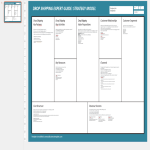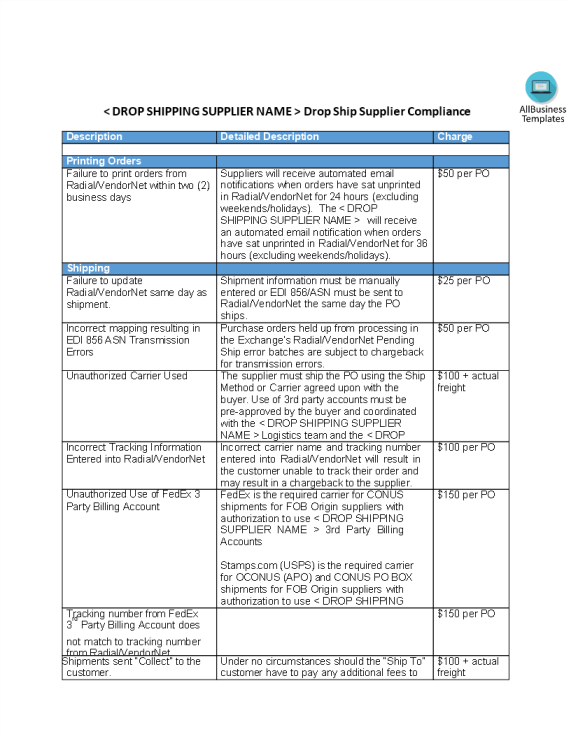Drop Shipping Strategy Model

I-Save, punan ang mga blanko, i-printa, Tapos na!
Are you developing a new drop shipping business and looking for the right questions to ask yourself how to make this drop shipping business successful? Download our Drop shipping Strategy Model poster template now and achieve your goals faster!
Ngayon: USD 3.59
I-download ngayon!

Mga magagamit na premium na format ng file:
.pptxIba pang magagamit na mga wika:
- Itong dokumento ay sertipikado ng isang Propesyonal
- 100% pwedeng i-customize
Business Negosyo Sales Pagbebenta Internet drop shipping Marketing dropshipping drop shipping expert guide drop shipping expert drop shipping strategy poster drop shipping strategy dropshipping poster dropshipping strategy how to do dropshipping what is dropshipping what is drop shipping drop shipping strategy model webshop strategy webshop drop shipping supplier drop shipping agreement how to get started drop shipping PowerPoint online drop shipping drop shipping agreement manufacturer sample drop shipping agreement kasunduan sa sample drop drop factory drop shipping agreement ppt pptx simple powerpoint templates powerpoint template best PPT templates free download pinakamahusay na PPT template na download professional PowerPoint templates free download Libreng download ng mga template ng PowerPoint dropshipping template for suppliers dropshipping template para sa mga tagapagtustos free dropshipping template dropshipping template for stores drop shipping policy dropshipping supplier template dropshipping website free branded dropshipping template free dropshipping best dropshipping dropshipping templates drop shipping templates dropshipping business plan template dropshipping web templates best items to dropship best dropshipping companies
How to develop a drop shipping strategy? Are you developing a new drop shipping business and looking for the right questions to ask yourself how to make this drop shipping business successful? Download our Drop Shipping Expert Guide: Strategy Model A3 size poster template now and achieve your goals faster!
For those Drop Shipping Retailers who make the biggest impacts, have, what we call, a "high performance mindset”, are often using the best templates, obtaining the right information and asking themselves the right questions, we have the best Strategy Model available!
Motivations for partnerships:
Categories
Characteristics
Examples
Customer Segments
Types of resources
Channel phases:
Is your business more:
For those Drop Shipping Retailers who make the biggest impacts, have, what we call, a "high performance mindset”, are often using the best templates, obtaining the right information and asking themselves the right questions, we have the best Strategy Model available!
By going through this template and filling in the questions, you will know soon how successful your drop shipping business will be and how to improve.
The Drop Shipping Expert Guide: Strategy Model contains the following sections:
Drop Shipping Key Partners
Drop Shipping Key Partners
Who are our Drop Shipping Key Partners?
Who are our key suppliers?
Which Key Resources are we acquiring from partners?
Which Key Activities do partners perform?
Motivations for partnerships:
- Optimization and economy
- Reduction of risk and uncertainty
- Acquisition of particular resources and activities
Drop Shipping Key Activities
What Drop Shipping Key Activities do our Value Propositions require?
Our Distribution Channels?
Customer Relationships?
Revenue streams?
Categories
- Production
- Problem Solving
- Platform/Network
Value Propositions
What value do we deliver to the customer?
Which one of our customer’s problems are we helping to solve?
What bundles of products and services are we offering to each Customer Segment?
Which customer needs are we satisfying?
Characteristics
- Newness
- Performance
- Customization
- “Getting the Job Done”
- Design
- Brand/Status Price
- Cost Reduction
- Risk Reduction
- Accessibility
- Convenience/Usability
Customer Relationships
What type of relationship does each of our Customer Segments expect us to establish and maintain with them?
Which ones have we established?
How are they integrated with the rest of our business model? How costly are they?
Examples
- Personal assistance
- Dedicated Personal Assistance Self-Service
- Automated Services Communities
- Co-creation
Customer Segments
For whom are we creating value?
Who are our most important customers?
- Mass Market
- Niche Market
- Segmented
- Diversified
- Multi-sided Platform
Key Resources
What Key Resources do our Value Propositions require?
Distribution Channels?
Customer Relationships?
Revenue Streams?
Types of resources
- Physical
- Intellectual (brand patents, copyrights, data)
- Human
- Financial
Channels
Through which Channels do our Customer Segments want to be reached?
How are we reaching them now? How are our Channels integrated? Which ones work best?
Which ones are most cost-efficient?
How are we integrating them with customer routines?
Channel phases:
1. Awareness; How do we raise awareness about our company’s products and services?
2. Evaluation; How do we help customers evaluate our organization’s Value Proposition?
3. Purchase; How do we allow customers to purchase specific products and services?
4. Delivery; How do we deliver a Value Proposition to customers?
5. After sales; How do we provide post-purchase customer support?
Cost Structure
What are the most important costs inherent in our business model?
Which Key Resources are most expensive?
Which Key Activities are most expensive?
Is your business more:
- Cost Driven (leanest cost structure, low price value proposition, maximum automation, extensive outsourcing)
- Value Driven ( focused on value creation, premium value proposition)
Sample characteristics:
- Fixed Costs (salaries, rents, utilities)
- Variable costs
- Economies of scale
- Economies of scope
Revenue Streams
For what value are our customers really willing to pay?
For what do they currently pay?
How are they currently paying? How would they prefer to pay?
How much does each Revenue Stream contribute to overall revenues?
Types:
- Asset sale
- Usage fee
- Subscription Fees
- Lending/Renting/Leasing
- Licensing
- Brokerage fees
- Advertising
Fixed pricing
- List Price
- Product feature dependent
- Customer segment dependent
- Volume dependent
Dynamic pricing
- Negotiation( bargaining)
- Yield Management
- Real-time-Market
Try out our online free business templates, forms and contracts today. Save, fill-In the blanks, print …and done!
This template is modified by AllBusinessTemplates.com for Drop Shipping Retailers. It's initially based on the Business Model Canvas under CC licence.
DISCLAIMER
Wala sa 'site' na ito ang dapat ituring na legal na payo at walang abogado-kliyenteng relasyon na itinatag.
Mag-iwan ng tugon. Kung mayroon kang anumang mga katanungan o mga komento, maaari mong ilagay ang mga ito sa ibaba.


